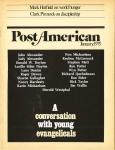The threat of global hunger looms more ominously than at any time in human history. Starvation and malnutrition are even now all too real for over a billion people in the world’s poorest countries. Most seriously stricken are South Asia and sub-Saharan Africa, where thousands are dying daily, and the physical and mental development of millions more are guaranteed to be critically retarded by malnutrition.
Earlier this year, Henry Kissinger called upon the United Nations to convene a World Food Conference to debate and act upon the many complex issues involved. Last November 1300 delegates from 130 countries gathered in Rome for the two-week conference. A few of the issues were dealt with. An early warning system was adopted to give more advanced indication of impending food deficits. An international grain reserve system was established to gather excess for years of shortage. An agricultural development fund was created to raise productivity in developing countries and a $10 million-per-year aid program was begun to provide direct funds for those countries suffering the most.
Beyond these minimal accomplishments, the conference was basically a failure with respect to both short and long-range goals. The blame lies primarily with the rich nations who called the conference. Their refusal to seriously deal with immediate needs and root causes of the food crisis showed their “concern” to be a facade.
Although climatic changes, overpopulation, energy costs, early-warning and grain reserve systems and inadequate technology in underdeveloped countries are all important elements, the single most critical problem concerning global hunger is the distribution of food products. Those who control the production and marketing of food products determine, more than any other factor, who gets how much food. Most of the world’s food resources are dominated by the U.S. and its agribusiness industry. In fact, the U.S. controls a larger share of the world’s exportable food resources than the Arab countries share of the world’s oil.
The facts of U.S. agricultural financial aid programs demonstrate a disproportionately small effort. Among sixteen donor nations in development assistance, the U.S. ranks fourteenth when aid is measured as a percentage of GNP. Furthermore, the U.S. Food for Peace program has been cut back and 40 percent of what remains goes to support the Thieu regime in Saigon.
The most recent U.S. refusal to provide substantial aid occurred at the conference itself. The most critical immediate need is to feed people in South Asia and sub-Saharan Africa. If food is not received in the next few months, millions will die of starvation in India, Pakistan, Sri Lanka, Ethiopia, and neighboring countries. Delegate after delegate from these countries spoke to stress the urgency of the situation. The United States, more than any other country, has the potential to help meet those needs. Under the pressure of several U.S. congressional representatives attending the conference (including Post American contributing editor Mark Hatfield), Agriculture Secretary Earl Butz, head of the U.S. delegation, wired President Ford, requesting a doubling of U.S. food aid to needy countries. It took Ford several days before wiring back his rejection of the proposal.
The most influential shaper of U.S. food policy is the agribusiness industry. The business of producing, processing, marketing, and retailing agricultural products has become a very profitable enterprise ($150 billion per year) and involves many of America’s largest corporations (including Exxon, General Motors, Ford, Gulf, DuPont and ITT). The control that these corporations have on food distribution and the impact of their decisions on global hunger can be clearly seen by using the grain industry as an example.
Détente has not been without its benefits for the grain industry. The huge wheat deals with the U.S.S.R. during the Nixon Administration gave the grain distributors incredible windfall profits. Although Ford, under congressional and public pressure, disallowed a similar deal last October, Secretary Butz has since indicated that large wheat shipments from the U.S. to U.S.S.R. will continue, but with more evenly spaced shipments. Due to profit margins, the huge grain corporations have decided it is better to feed Soviet cattle than the starving and undernourished masses of South Asia and sub-Saharan Africa.
For similar reasons cattle are stuffed with eight pounds of grain for every pound of beef produced--enough grain to feed an Indian adult for one week. Hatfield and Butz had a confronting interaction on the conference floor when Hatfield urged that the U.S. cut down on its beef consumption, freeing the unused grain for distribution in the famine-stricken areas. Butz countered that animal forage could not be directly transferred into food aid because it was unusable that way. Butz’s argument is bogus because an important forage --sorghum--is part of many Indian diets. Again, the distributors use their grain to satisfy profitable, inefficient consumptive patterns in the U.S. while starvation and malnutrition continue abroad.
The wealthy nations cannot feign compassion by convening global food conferences or even increasing their food aid abroad. Their institutions have done more to create the conditions of global hunger than anything else; and their consumptive lifestyles reinforce those institutions and perpetuate the economic disparity, between rich and poor. When the Conference failed to recognize these systemic causes, it forfeited any real chance of alleviating the suffering of over a billion people.
A wealthy church in a hungry world is a disobedient church. Our wealth is derived from the institutions of the rich--some of the very principalities and powers our Lord charged us to oppose. To renounce our wealth and distribute our excess to the poor and hungry masses is the obedient response to global hunger that our Lord demands.
Joe Roos was on the editorial staff at the Post American when this article appeared.

Got something to say about what you're reading? We value your feedback!
